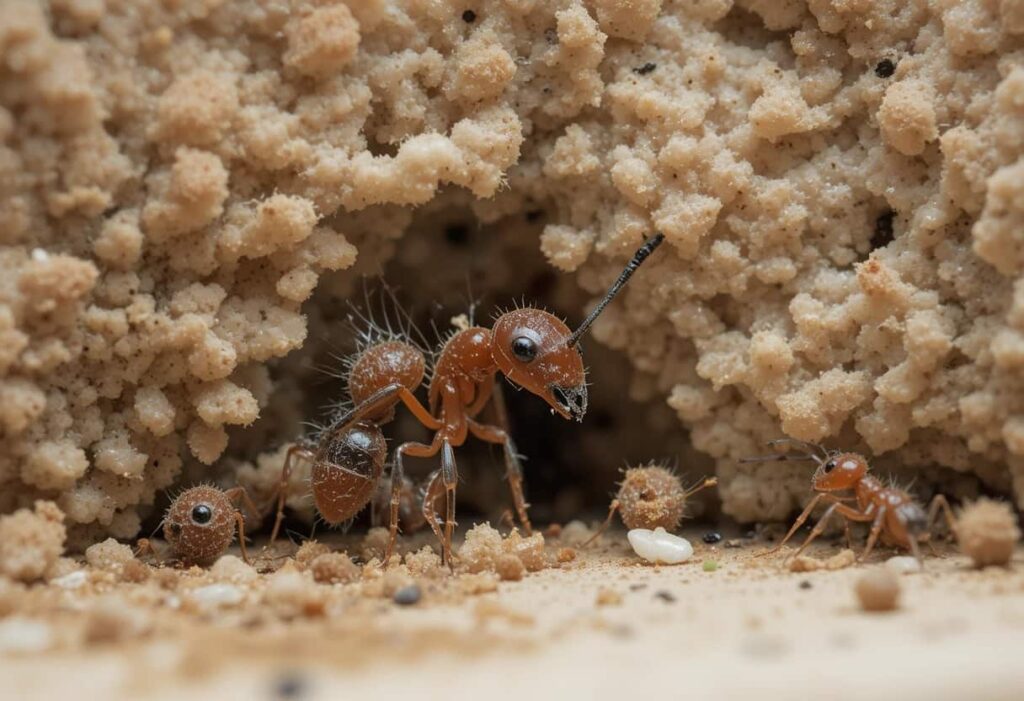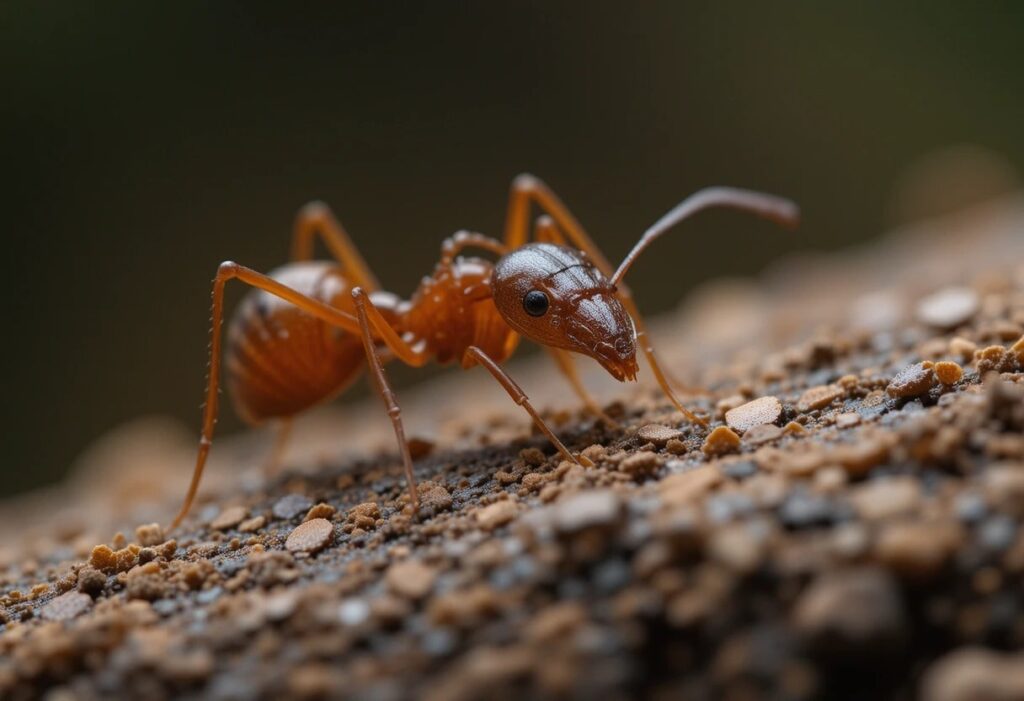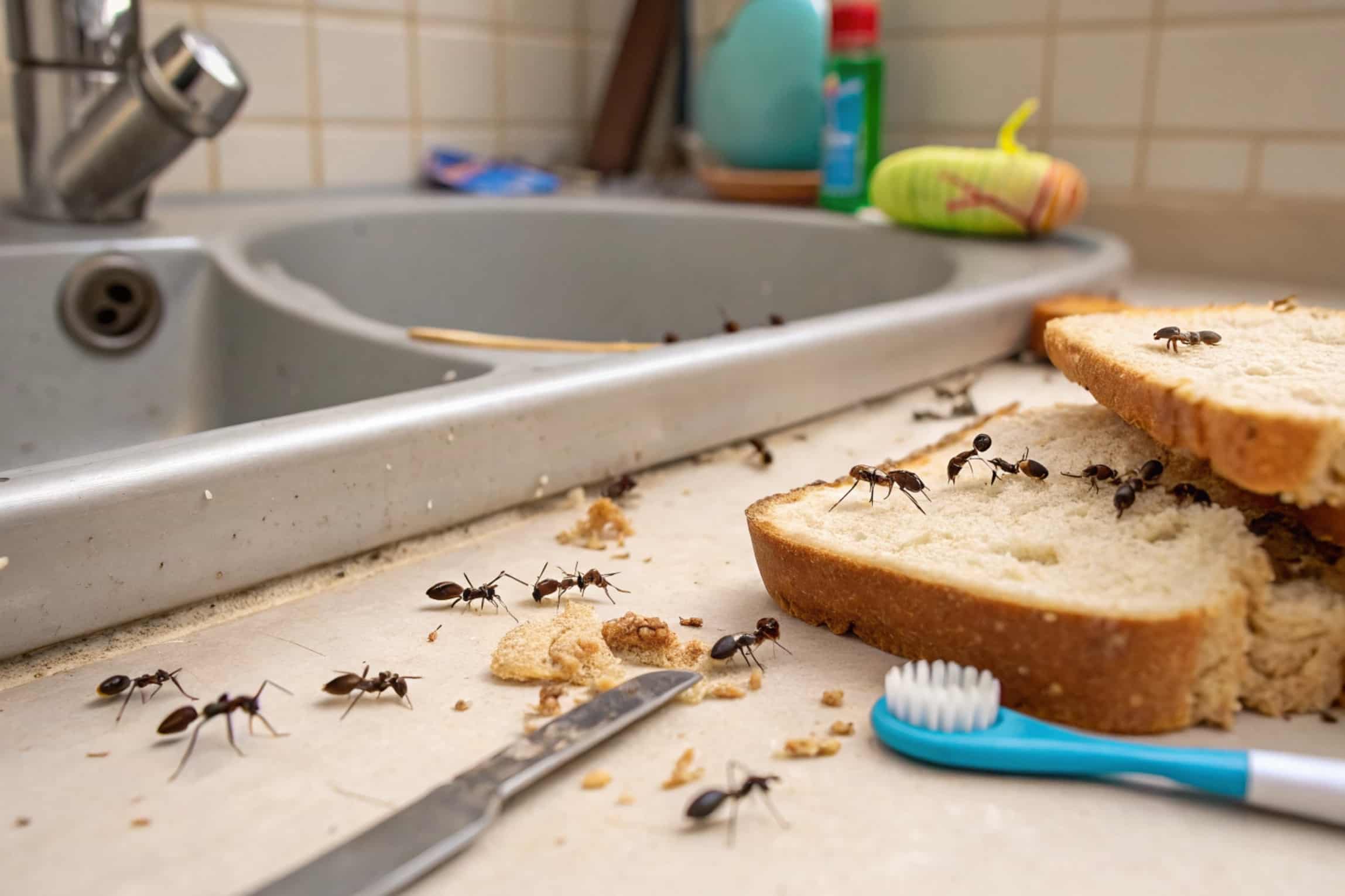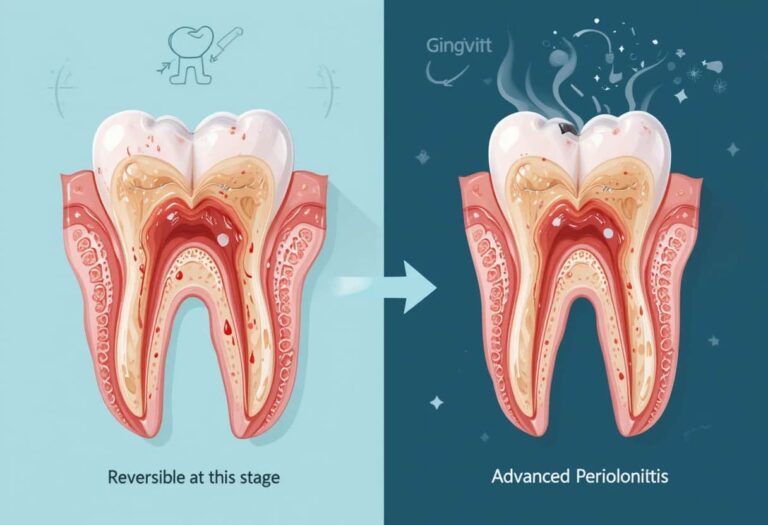Do Ants Spread Disease – Fast Facts Revealed!
Ants are among the most widespread and persistent household pests. They march in long trails across kitchen counters, sneak into food containers, and show up in bathrooms, trash bins, and even electronic devices. Although ants seem more like an inconvenience than a real threat, there’s growing concern about their potential to affect human health. Unlike ticks or mosquitoes, ants are not known for transmitting disease directly through blood or bites. However, what they do is just as serious — they act as mechanical carriers of harmful bacteria, spreading pathogens across your home without you even realizing it.
Once ants make it into your home, they don’t just stop at food. They move through drains, garbage, toilets, pet bowls, and dirty laundry, and then crawl across clean surfaces, tables, and plates. This movement can transfer microorganisms from unsanitary areas to places where food is stored or eaten, creating a serious risk of cross-contamination. For families with young children, elderly relatives, or immunocompromised individuals, this can quickly turn into a real health hazard.
How Ants Become a Health Threat Indoors?
One of the key things to understand about ants is how easily they adapt to human environments. Their small size allows them to squeeze through the tiniest of cracks in walls, under doors, or around plumbing fixtures. Once inside, they are constantly searching for resources—most often, sugar, proteins, and water. And wherever they go, they carry microscopic particles on their bodies, including germs, dirt, fecal matter, and bacterial spores.

These contaminants often originate from unsanitary places such as outdoor garbage bins, sewers, pet waste, and public walkways. When ants move from these dirty areas into clean areas like kitchen counters, food storage zones, or cutlery drawers, they create a silent chain of contamination that may result in foodborne illnesses or infections.
What Harmful Bacteria Can Ants Carry Into Your Home?
Extensive research and pest control studies have found that ants can carry dangerous microorganisms on their bodies. These bacteria are especially harmful when transferred to food, utensils, or kitchen surfaces.
- Salmonella: This bacterium causes severe food poisoning, often leading to symptoms such as vomiting, fever, and diarrhea. It’s commonly spread through contaminated food or surfaces that ants have walked across unnoticed.
- E. coli: E. coli exposure can result in abdominal pain, cramps, and, in severe cases, kidney failure. Ants can transfer this bacterium from dirty areas directly onto food-preparation surfaces or exposed meals.
- Shigella: Shigella is linked to contaminated water and food. It can cause bloody diarrhea, stomach cramps, and fever. Ants can spread this pathogen by moving between dirty drains and food-handling areas.
- Clostridium perfringens: This bacterium causes gastrointestinal illness and is a frequent culprit in food poisoning outbreaks. Ants picking it up from waste areas can contaminate food storage or serving spots.
- Staphylococcus aureus and Streptococcus: These bacteria, often found on skin and surfaces, can cause skin infections, respiratory issues, or severe complications if introduced into wounds or sterile zones by ants.
These pathogens pose serious health risks, especially because ants can move from contaminated areas to clean ones silently and rapidly, leaving trails of bacteria that are invisible to the naked eye.
Are Ant Bites Dangerous for Humans?
Although ants are small and generally not aggressive, certain species can bite or sting when provoked, and the effects can be more serious than many realize. Most household ants are harmless and may never bite. However, species such as fire ants, carpenter ants, and red imported fire ants can pose legitimate health risks through their painful stings or bites.

These aggressive ants defend their colonies by attacking perceived threats, and their bites can lead to a variety of symptoms ranging from mild irritation to severe allergic reactions. The impact of a bite can vary based on the individual’s sensitivity, the species involved, and how many ants are involved in the attack.
Common Reactions from Ant Bites or Stings:
- Itching, redness, and swelling: These are the most common responses to an ant bite. The area may become warm and irritated within minutes.
- Painful burning sensation: Especially common with fire ant stings, which inject venom that causes a sharp, burning pain followed by the formation of pustules or blisters.
- Allergic reactions: In some people, the venom can cause hives, difficulty breathing, dizziness, or swelling in areas beyond the bite.
- Skin infections: Bites that are scratched open can easily become infected by bacteria, particularly in warm, humid conditions.
- Anaphylactic shock: Though rare, this life-threatening allergic reaction can occur in highly sensitive individuals and requires immediate emergency treatment.
- Cellulitis: A bacterial skin infection that may develop if bacteria enter through the broken skin, causing red, inflamed areas that spread rapidly.
How Ants Create Cross-Contamination?
Ants Transfer Germs from Dirty to Clean Areas:
Ants often move through unhygienic zones like garbage bins, toilets, and pet litter before crawling onto clean household surfaces. This transition allows them to unknowingly carry bacteria from unsanitary spots into kitchens, dining areas, and bedrooms. Their constant movement between these environments makes them effective carriers of harmful microorganisms, spreading contamination without detection.
Kitchen Surfaces Become Contaminated Easily:
When ants travel across kitchen counters, cutting boards, or sinks where raw meat was recently prepared, they can leave behind dangerous pathogens. These include salmonella, E. coli, and other foodborne bacteria. Since the contamination isn’t visible, families might continue using the space without disinfecting it—potentially exposing themselves to infections through normal food preparation activities.
Food Items Are Quickly Exposed:
Once ants locate an unsealed food source, they enter packaging or containers with ease. Sugar, bread, fruits, and snacks become direct points of contamination. Even brief contact with ant-infested food can introduce bacteria. These germs may not cause immediate illness but can lead to food poisoning, especially in children, elderly people, or immune-compromised individuals.
Toys and Personal Items Carry Risks:
Ants crawling across baby toys, toothbrushes, or personal care items can transfer harmful bacteria. These everyday objects, especially those handled by children, are easily overlooked during cleaning. When ants contaminate these items, the risk of bacteria entering the mouth or eyes increases significantly, making even simple contact potentially harmful for family members, especially infants.
Why Kitchens Are Ant Hotspots?
Kitchens are prime targets for ant activity. The abundance of food sources, sugary residues, moisture, and warmth provides ants with everything they need to thrive. Even a small spill of juice, some crumbs on the floor, or an open jar of honey can attract dozens of ants in a matter of hours.
Unsealed containers, unwashed dishes, and trash bins without lids further increase the risk of contamination. And because ants often build their nests behind appliances or inside walls, it’s common to miss the early stages of an infestation — until it’s too late.
Medical Facilities and the Rising Concern of Ant-Driven Contamination – Hidden Threats Inside!
One of the more alarming discoveries in recent years is the presence of ants in healthcare facilities. Research has shown that Pharaoh ants, in particular, are frequent invaders of hospitals and clinics. They have been found near IV drips, wound dressings, and even inside sterile medical equipment.
This poses an enormous risk for patients, especially those recovering from surgery or those with weakened immune systems. In these settings, ants are not just a nuisance; they become potential agents of hospital-acquired infections, which can be life-threatening.
Several studies have proven that ants collected from hospitals were carriers of Staphylococcus aureus, E. coli, and Pseudomonas aeruginosa— all dangerous and often antibiotic-resistant pathogens.
Why Do Ant Infestations Keep Coming Back Despite Treatment?
- The Queen Remains Alive: Most DIY treatments only kill worker ants. If the queen survives, she continues laying thousands of eggs, quickly rebuilding the colony within days or weeks.
- Multiple Nesting Sites: Ant colonies often split into several satellite nests. Treating one area without finding others allows the remaining nests to stay active and repopulate.
- Pheromone Trails Aren’t Removed: Ants leave behind scent trails that guide others to food and water. If these aren’t cleaned thoroughly, new ants will follow the same path into your home.
- Hidden Entry Points: Cracks in walls, windows, or foundations offer ants ongoing access. Without sealing these tiny gaps, infestations can easily return even after treatments.
- Incomplete or Short-Term Treatments: Many store-bought sprays offer temporary relief but don’t address the root problem. Without professional intervention or long-term pest control strategies, ants will inevitably come back.
Who Is Most at Risk from Ant-Related Diseases?

Infants and Toddlers:
Young children frequently put toys, hands, and objects in their mouths. If ants have crawled over these items, harmful bacteria may be ingested, leading to infections or stomach illnesses. Their developing immune systems make it harder to fight off these pathogens, increasing the risk of more serious symptoms from even mild contamination.
Elderly Individuals:
As people age, their immune response naturally weakens, making them less effective at resisting infections. Ant-related bacteria, like salmonella or E. coli, can cause prolonged illnesses in seniors. Even minor infections can become severe quickly, especially if they have underlying conditions like diabetes or cardiovascular disease that further reduce their resistance.
Pregnant Women:
During pregnancy, the immune system becomes more sensitive, making expectant mothers more vulnerable to foodborne illnesses. Bacteria spread by ants can trigger nausea, diarrhea, or even complications like dehydration and fever. In some cases, exposure to certain pathogens could pose risks to fetal development, making pest prevention especially important during pregnancy.
Immunocompromised People:
People undergoing chemotherapy, living with autoimmune disorders, or on immunosuppressive drugs are less able to fight off infections. For them, bacteria transferred by ants can result in severe, hard-to-treat illnesses. What might be a mild case of food poisoning for others can lead to hospitalization or prolonged recovery for immunocompromised individuals.
Allergy-Prone and Skin-Sensitive Individuals:
Individuals with allergies or chronic skin conditions like eczema may have stronger reactions to ant bites or surface contamination. Scratching irritated skin can break the barrier, allowing bacteria to enter the body. This can lead to secondary infections like cellulitis, which are especially concerning for those with sensitive or damaged skin.
How to Prevent Ants from Spreading Diseases in Your Home?
- Seal all entry points: Use caulk to close gaps in doors, windows, and walls. Blocking these small openings prevents ants from entering and spreading bacteria across your kitchen, pantry, and other sensitive areas.
- Keep food properly sealed: Store all food in airtight containers, especially sweet and sticky items. Open or loosely packed food invites ants, increasing the risk of contamination through contact with their bacteria-covered bodies.
- Fix leaks and remove moisture: Ants are highly attracted to water. Repair dripping pipes, leaky faucets, and keep bathrooms and sinks dry to reduce moisture sources that support colony survival and growth.
- Clean surfaces and take out trash daily: Crumbs, spills, and leftover food attract ants. Daily cleaning and prompt trash disposal make your home less appealing and limit their access to bacteria-spreading food sources.
- Call pest control if needed: If you notice regular trails, wall rustling, or visible nests, contact professionals. They can locate the colony and use targeted treatments to eliminate ants and stop them from spreading disease.
What Are the Long-Term Effects of Ignoring Ant Infestations?
Ignoring an ant problem may seem harmless, but it can lead to serious long-term consequences. Ants can contaminate food, worsen allergies or asthma, and spread bacteria that trigger skin infections. In sensitive environments like kitchens or healthcare settings, they compromise sanitation. Carpenter ants also cause structural damage by tunneling through wood.
Since ants reproduce rapidly, infestations can grow quickly and silently. Even if one colony is removed, others may return if your home isn’t properly secured. Early prevention and timely action are key to avoiding costly and persistent problems. Unchecked infestations may also attract other pests like cockroaches or rodents. Over time, this creates a hazardous living environment and impacts overall indoor air quality.
FAQs:
1. What is the source of Josie’s illness in Klara and the Sun?
Josie’s illness is linked to a genetic modification called “lifting,” which is used to enhance children’s intellectual abilities. Although lifting offers social advantages, it carries serious health risks. Josie’s frailty and unexplained illness are a direct result of this genetic alteration.
2. What made Josie sick in Klara and the Sun?
Josie became ill due to complications from being “lifted.” The novel subtly critiques the societal pressure for parents to genetically enhance their children, highlighting how the procedure can compromise physical health in exchange for future educational or professional opportunities.
3. What healed Josie in Klara and the Sun?
While her recovery isn’t fully explained medically, it’s deeply tied to Klara’s faith in the Sun’s healing power. Klara believes the Sun can restore Josie’s health, and Josie begins to recover after Klara performs rituals and makes symbolic sacrifices, blending science fiction with spiritual allegory.
4. What is the significance of the Cootings Machine in Klara and the Sun?
The Cootings Machine represents pollution, industrialism, and a threat to the purity Klara associates with the Sun. It blocks sunlight, and Klara views it as a source of harm. Her decision to damage it reflects her belief that eliminating it will help Josie heal.
5. How does Klara’s belief in the Sun shape the story’s themes?
Klara’s devotion to the Sun as a healing force introduces spiritual and symbolic depth. Her belief mirrors human tendencies toward faith and hope, even in artificial beings. It raises questions about consciousness, love, and whether belief alone can drive real change in a scientifically advanced world.
Conclusion:
While ants may appear to be minor household nuisances, their presence can lead to serious health concerns. By carrying harmful bacteria and contaminating food, surfaces, and personal items, ants become silent vectors of disease, particularly dangerous for vulnerable individuals. Understanding their behavior, risks, and prevention methods is crucial—not only for protecting your health but also for maintaining a hygienic, safe living environment.
Action and consistent cleanliness are essential in keeping ant infestations under control and avoiding long-term consequences. Ignoring the problem can also attract other pests like cockroaches or rodents, compounding the risks. To safeguard your home, it’s vital to combine prevention with timely professional intervention when necessary.
Related post:






